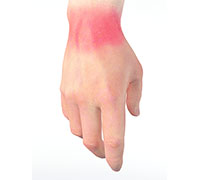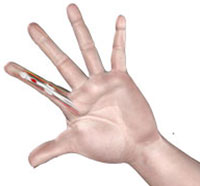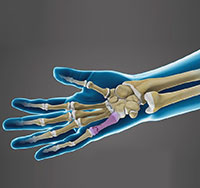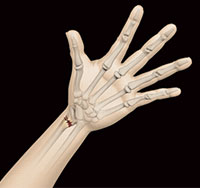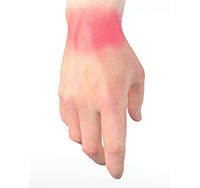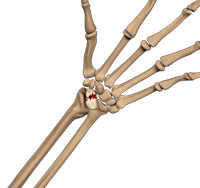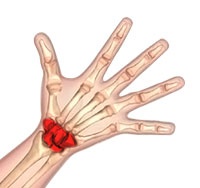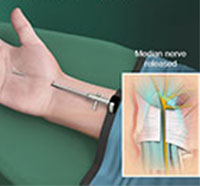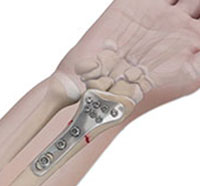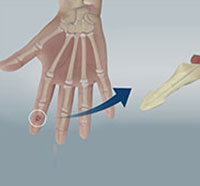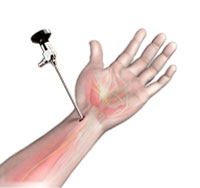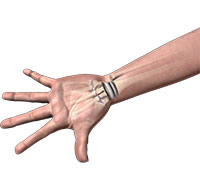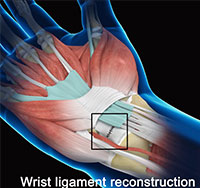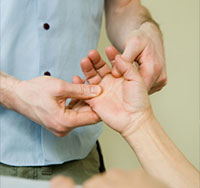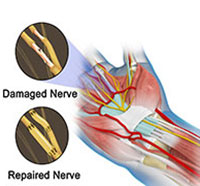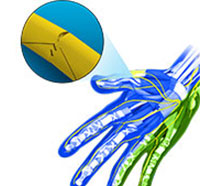-
Hand pain is an unpleasant sensation in the joints and tissues of the hand or fingers. It can be depicted as pulsating, aching, increased warmth, prickling, irritation and inflexibility. The hand is composed of nerves, bones, blood vessels, muscles, tendons and skin.
-
The ability to bend the fingers is governed by supportive tendons that connect muscles to the bones of the fingers. The tendons run along the length of the bone and are kept in place at intervals by tunnels of ligaments called pulleys.
-
Dupuytren's Contracture is a hand condition where thickening of the underlying fibrous tissues of the palm cause the fingers to bend inward. Patients with this condition are unable to fully straighten the affected fingers.
-
The muscles and bones of the hand are connected by thick flexible tissue called tendons. Tendons are covered by a thin soft sheath of tissue known as synovium. Extensor pollicis brevis and abductor pollicis longus are two tendons located on the thumb side of the wrist.
-
Carpal Tunnel Syndrome is a common, painful, progressive condition that is caused by compression of the median nerve at the wrist area.
-
The wrist is more prone to injuries/problems that may include sprains and strains as well as fractures can occur with lifting and carrying heavy objects, wrist injury while operating machinery, bracing against a fall, or sports-related injuries.
-
Tendons are the bands of fibrous connective tissue that connect muscles to bone. Tendons aid in the movement of the fingers, hand and all other body parts.
-
The wrist is comprised of two bones in the forearm, the radius and ulna, and eight tiny carpal bones in the palm. The bones meet to form multiple large and small joints. A wrist fracture refers to a break in one or more of these bones.
-
The hand is one of the most flexible and useful parts of our body. Because of overuse in various activities, the hands are more prone to injuries, such as sprains and strains, fractures and dislocations, lacerations and amputations while operating machinery, bracing against a fall and sports-related injuries.
-
A nail is the hard covering at the end of the dorsal side of your fingers and toes. The nail is composed of a nail plate, nail matrix (a tissue that protects nails) and nail bed. The nail plate is a hard, translucent part of the nail composed of a protein called keratin.
-
The forearm consists of two bones, the radius and ulna. The radius is the larger of the two forearm bones, and the region towards the wrist is called the distal end. Fractures in this end are most common.
-
Injuries caused due to stretching or tearing of the ligaments in the wrist are called wrist sprains. These injuries are usually caused by a fall during daily activities or sports activities. Sprains can range from mild to severe based on the extent of injury to the ligament.
-
A laceration is a tear or ragged opening in the skin usually caused by an injury or trauma. A laceration may be either a partial laceration or a complete laceration. Tendons connect muscles to bones and allow coordinated movement of the joints. A deep cut or laceration on the palm side of the hand can damage the flexor tendons, which control movement in your hand.
-
The scaphoid bone is a small, boat-shaped bone in the wrist, which, along with 7 other bones, forms the wrist joint. It is present on the thumb side of the wrist causing it to be at high risk for fractures. A scaphoid fracture is usually seen in young men aged 20 to 30 years. They can occur at two places: near the thumb or near the forearm.
-
Ganglion cysts are swellings that most commonly develop along the tendons or joints of wrists or hands. They can be found either at the top of the wrist, palm side of the wrist, end joint of a finger, or at the base of a finger. A ganglion cyst is not cancerous and will not spread to the other parts of the body.
-
Mallet finger is a condition where the end of the finger is bent and does not straighten. It occurs when the extensor tendon on the back of the finger is damaged. The finger joint is a hinge joint that allows bending and straightening of the fingers. Each finger is composed of 3 phalanges bones, joined by 2 interphalangeal joints (IP joints).
-
Arthritis is an inflammatory condition of joints. There are several types of arthritis and the most common type is osteoarthritis or wear-and-tear arthritis. Arthritis affects various joints in the body and arthritis in hand affects the joint at the base of the thumb.
-
Arthritis is an inflammatory condition of joints. There are several types of arthritis; the most common type is osteoarthritis or wear-and-tear arthritis that affects the joint at the base of the thumb. Thumb arthritis is more common in women than men and usually occurs after the age of 40 years.
-
Hands become infected more frequently as it is one of the commonly injured parts of our body. Hand infections, if left untreated or treated improperly can cause disabilities such as stiffness, contracture, weakness, and loss of tissues (skin, nerve and bone) that persist even after the infection resolves.
-
Kienbock's disease is a condition in which the lunate, one of the small bones of the wrist loses its blood supply leading to the death of the bone. This results in pain, stiffness, and degenerative changes in the wrist joint.
-
Tendons in your fingers connect the finger bones to finger muscles and help bend and straighten the finger at the joint when the muscles contract. Boutonnière deformity is a condition in which a tendon injury to the middle joint of the finger results in the inability to straighten the affected finger.






 Dr. Nicholas M. Chabrel
Dr. Nicholas M. Chabrel Dr. Basel Masri
Dr. Basel Masri Dr. Michael J. Sandow
Dr. Michael J. Sandow Dr. Chen Tu
Dr. Chen Tu Dr. Arthur Turow
Dr. Arthur Turow





